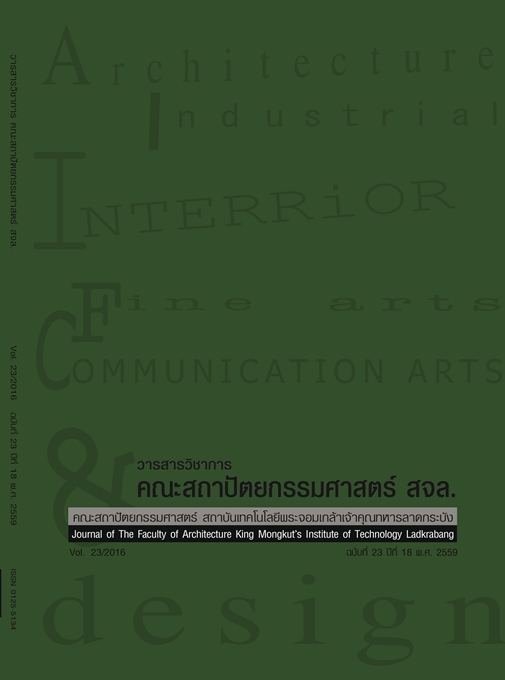การรับรู้อัตลักษณ์ล้านนาผ่านทางสถาปัตยกรรมในจังหวัดเชียงใหม่ (Perception of Lanna Identity via Architecture in Chiang Mai Province)
Main Article Content
Abstract
บทคัดย่อ
สถาปัตยกรรมนอกจากการทำหน้าที่ในเรื่องประโยชน์ใช้สอยแล้ว ยังเป็นสื่อทางสายตาในการถ่ายทอดเรื่องราวที่เป็นนามธรรมต่างๆ อีกด้วย ในเบื้องต้น สถาปัตยกรรมแต่ละแห่งย่อมสื่อสารถึงแนวคิดและหรือปรัชญาการออกแบบของช่างหรือสถาปนิก แต่เมื่อสถาปัตยกรรมทั้งหลายของท้องถิ่นถูกรวมเป็นกลุ่มเดียวกัน การสื่อสารของกลุ่มจะเป็นเรื่องราวทางสังคมและวัฒนธรรมของท้องถิ่นนั้นๆ ซึ่งเห็นได้จากเมืองที่มีอัตลักษณ์หลายแห่งในโลก อาทิ โรม เกียวโต เป็นต้น ในประเทศไทยเชียงใหม่เป็นจังหวัดหนึ่งในกลุ่มจังหวัดภาคเหนือของประเทศไทยที่สืบทอดวัฒนธรรมล้านนา ภายในเขตเมืองเชียงใหม่ มีสถาปัตยกรรมเก่าและใหม่เป็นจำนวนมาก มีความหลากหลายทั้งรูปแบบและการใช้สอย ทำให้อัตลักษณ์ล้านนาของเมืองเลื่อนไป การวิจัยนี้มีวัตถุประสงค์เพื่อศึกษาว่า การรับรู้อัตลักษณ์ล้านนาผ่านทางสถาปัตยกรรมในจังหวัดเชียงใหม่มีประสิทธิผลอย่างไร ผลการวิจัยพบว่า ชาวไทยและชาวต่างชาติมีความคิดเห็นว่าสามารถรับรู้อัตลักษณ์ล้านนาผ่านทางสถาปัตยกรรมส่วนประกอบสถาปัตยกรรม และรายละเอียดของสถาปัตยกรรมได้มากถึงมากที่สุด โดยเฉพาะกลุ่มไม้แกะสลัก ซึ่งสามารถนำไปประยุกต์ใช้ในการออกแบบสถาปัตยกรรมและสถาปัตยกรรมภายในเพื่อสร้างการรับรู้อัตลักษณ์ล้านนาและการพัฒนาอัตลักษณ์ล้านนาให้มีความยั่งยืนในอนาคต
คำสำคัญ: การรับรู้ การรับรู้ทางสายตา อัตลักษณ์ อัตลักษณ์ล้านนา สถาปัตยกรรมล้านนา
Abstract
Besides functional purposes, architectures also act as a visual mean to communicate abstract contents to people. Initially, each individual architecture usually conveys concepts or philosophies of its builders and
architects. However, once these architectures in one community are grouped together, they can communicate the story of social and culture of the community. This characteristics can be seen in several major cities in
the world such as Rome and Kyoto for instance. In Thailand, the city of Chiang Mai is a part of the Northern Provinces those inherit Lanna culture where old and new architectures with diversities both in functions and
in styles are observed. The large diversities of architecture and styles sometimes can obscure Lanna identity of the city. This research explores how effective can Lanna identity be expressed via architectures in Chiang Mai. The findings show both Thais and foreigners have a similar opinion that Lanna identity in Chiang Mai can be expressed via architecture, architectural elements and details very effectively. earticularly wood carving. The findings contribute to the development of architecture and interior design in Chiang Mai to sustain the Lanna identity perception in the future.
Keyword: Perception Visual Perception Identity Lanna identity Lanna Architecture
Article Details
This work is licensed under a Creative Commons Attribution-NonCommercial-ShareAlike 4.0 International License.
Copyright Transfer Statement
The copyright of this article is transferred to Journal of The Faculty of Architecture King Mongkut's Institute of Technology Ladkrabang with effect if and when the article is accepted for publication. The copyright transfer covers the exclusive right to reproduce and distribute the article, including reprints, translations, photographic reproductions, electronic form (offline, online) or any other reproductions of similar nature.
The author warrants that this contribution is original and that he/she has full power to make this grant. The author signs for and accepts responsibility for releasing this material on behalf of any and all co-authors.


